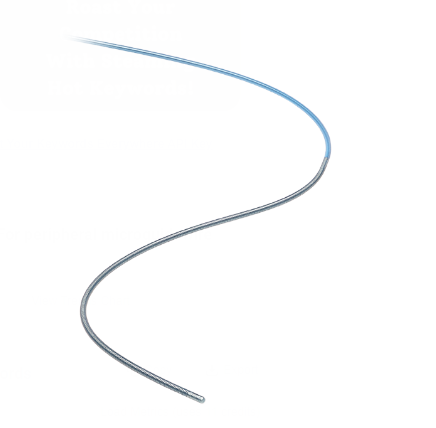Why Is the Peripheral Microguidewire Essential for Vascular Interventions? Imagine you’re performing a complex peripheral vascular procedure, navigating through narrow and tortuous vessels, attempting to restore blood flow to a patient with severe peripheral artery disease. In such high-stakes situations, precision and control are paramount. This is where the peripheral microguidewire comes into play. With advanced features like a platinum spring tip, hydrophilic coating, and optimized torsional control, this specialized medical device has revolutionized peripheral vascular interventions. But how can healthcare professionals maximize its effectiveness and ensure the best outcomes for their patients?

This blog provides key insights into the best practices for using peripheral microguidewires and tips to help medical professionals navigate the challenges of vascular interventions.
What Is a Peripheral Microguidewire?
A peripheral microguidewire is a highly specialized tool used in diagnostic and interventional vascular procedures. It allows for precise navigation through the peripheral vasculature, helping surgeons access targeted areas while minimizing the risk of vessel damage. Composed of high-quality materials, including stainless steel and NiTi memory alloy, peripheral microguidewires are known for their flexibility, durability, and maneuverability. Their unique structure makes them an indispensable component in peripheral vascular treatments such as angiography, angioplasty, and thrombectomy.
Structure and Design Specifications
The structure of a peripheral microguidewire plays a crucial role in its effectiveness during procedures. The proximal section is typically made from stainless steel, offering rigidity and control, while the distal section incorporates a NiTi (nickel-titanium) memory alloy for added flexibility. A PTFE coating on the proximal end reduces friction, while the hydrophilic coating on the distal end enhances tracking and operability through calcified or complex lesions.
Key specifications include:
Size: 0.014″ diameter, ideal for peripheral procedures.
Effective Length: 180-300 cm, allowing for use in longer vessels.
Tip Configuration: Straight, with the option for various tip hardness specifications depending on the lesion being treated.
These design features ensure that peripheral microguidewires offer the necessary support and precision, allowing physicians to navigate challenging anatomy safely.
Platinum Spring Tip for Enhanced Visualization
The platinum spring tip at the distal end of the microguidewire serves a dual purpose. First, it provides enhanced visibility under fluoroscopy, allowing physicians to track the wire’s exact location in real-time. This is especially critical during procedures like peripheral angiography and stenting, where precise placement is essential. Second, the spring tip helps reduce the risk of vessel injury by distributing pressure more evenly, preventing accidental perforation or damage to delicate vessels.
Hydrophilic Coating for Seamless Navigation
One of the most critical features of a high-quality peripheral microguidewire is the hydrophilic coating applied to the distal section. This coating allows the guidewire to glide through difficult lesions, such as those caused by calcification or complex vessel narrowing, with minimal resistance. The smooth tracking capability significantly improves procedural success rates, especially in patients with advanced peripheral arterial disease (PAD). In addition, the coating reduces the risk of embolism or vessel trauma, contributing to safer outcomes.
Optimized Torsional Control for Precision
Another standout feature of the peripheral microguidewire is its optimized torsional control. This 1:1 torque ratio ensures that any rotation applied to the proximal end translates accurately to the distal tip. In practice, this means the surgeon can guide the wire through complicated vessel networks with pinpoint accuracy, minimizing the need for readjustment and reducing procedural time. This precise control is particularly useful in navigating through tortuous anatomy, where even slight deviations can lead to complications.

Applications of Peripheral Microguidewires
Peripheral microguidewires are used in a wide variety of diagnostic and therapeutic procedures aimed at restoring blood flow and treating vascular conditions. Below are some of the most common applications:
Peripheral Angiography
In peripheral angiography, microguidewires provide the necessary vascular access for diagnostic imaging. They help facilitate the smooth navigation of catheters and other devices through peripheral vessels, allowing physicians to visualize blockages or abnormalities. Their flexible design and hydrophilic coating enable seamless passage through narrowed or tortuous vessels, which is often essential in getting accurate imaging results.
Peripheral Angioplasty and Stenting
Peripheral angioplasty and stenting are among the most common uses for microguidewires. These procedures require the precise placement of balloons and stents to open up narrowed or blocked arteries and restore blood flow. The ability of the microguidewire to traverse complex lesions, along with its superior torsional control, allows for accurate stent placement, reducing the risk of restenosis and other complications.
Peripheral Atherectomy
In cases where plaque buildup is severe, peripheral atherectomy is performed to remove the hardened plaque from artery walls. It helps to safely navigate atherectomy devices to the lesion, ensuring that the device reaches its target without damaging healthy tissue.
Peripheral Embolization
Peripheral embolization procedures require delicate navigation to treat vascular malformations or stop bleeding. The microguidewire’s hydrophilic coating and flexibility make it ideal for guiding embolization devices to the precise location, ensuring successful treatment of the vascular issue.
Peripheral Thrombectomy
In acute thrombotic occlusions, where blood clots block the vessel, peripheral microguidewires are used to guide thrombectomy devices to the site of the blockage. The wire’s flexibility and tip design allow it to bypass the clot safely, providing a pathway for clot removal and restoring blood flow.
Best Practices for Using Peripheral Microguidewires
To maximize the effectiveness of peripheral microguidewires, medical professionals should follow several best practices:
1. Understand the Anatomy
Before starting any procedure, physicians should have a thorough understanding of the patient’s vascular anatomy. Advanced imaging techniques such as ultrasound or CT angiography can provide valuable insights into vessel size, tortuosity, and the presence of lesions, allowing for more informed decision-making regarding the choice of microguidewire.
2. Choose the Appropriate Guidewire
Selecting the right guidewire is crucial to the success of the procedure. The hardness of the tip, length of the wire, and coating all play important roles in different clinical scenarios. For example, a softer tip may be needed for navigating through tortuous anatomy, while a stiffer tip may be better suited for crossing calcified lesions.
3. Handle with Care
Peripheral microguidewires are delicate instruments that require precise handling. Excessive force or improper manipulation can lead to complications such as vessel perforation or wire kinking. Physicians should use gentle movements and avoid excessive torque to maintain the integrity of the wire and prevent damage to the vessel.
Conclusion: Why Tianjin Demax Medical Technology Co., Ltd. Stands Out
Tianjin Demax Medical Technology Co., Ltd., a leading supplier of peripheral microguidewires, offers world-class products designed to meet the needs of modern healthcare professionals. Dimac has more than ten years of OEM/ODM service experience. Establish strategic partnerships with leading European and American companies to provide high-quality, customized vascular interventional solutions.

Key Advantages of Demax Microguidewires:
A multidisciplinary professional R&D team that ensures cutting-edge technology.
World-class production facilities equipped with automated production lines.
Unique, patented technologies that provide superior product performance.
Strong and stable supply capacity, ensuring rapid, large-scale delivery.
Whether you are having a complex angioplasty, stent placement or thrombectomy. Demax’s peripheral microguidewires all provide the precision, durability and control needed for successful results. By following best practices and selecting the appropriate guidewire for each procedure. Healthcare professionals can ensure better patient outcomes and higher surgical success rates.
Ready to enhance your vascular interventions? Explore Demax’s world-class peripheral microguidewire solutions today!